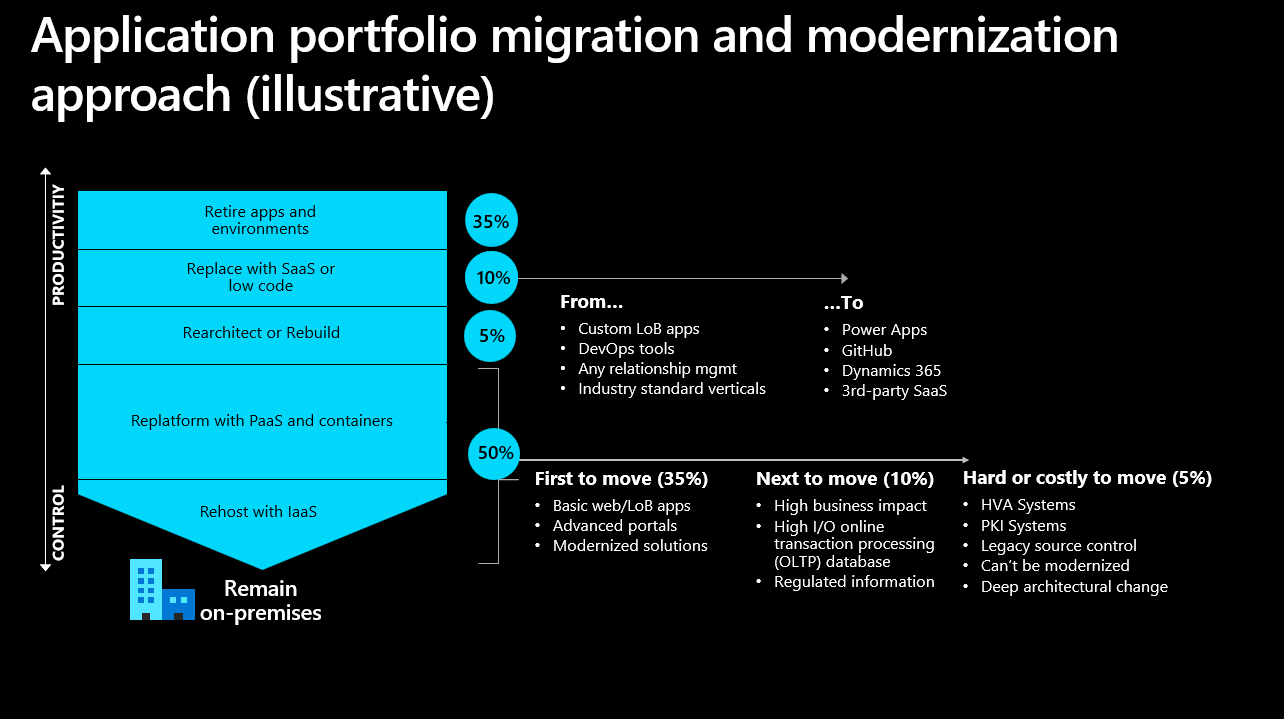Cloud adoption journey
Cloud adoption journeys tend to follow similar trajectories. Variations exist, but it can still be helpful to see how others adopt the cloud. Knowing what workloads to tackle first and what to do with them will streamline your cloud adoption journey.

An important consideration in adopting the right cloud solution is the balance of control versus productivity. Infrastructure as a service (IaaS) solutions give you the most control but require more time to maintain. Platform as a service (PaaS) and software as a service (SaaS) solutions transfer management responsibility to Azure and allow your teams to focus on being productive. The balance needed between control and productivity is different for every organization, and it will change over time as your priorities change.
For the initial cloud adoption, a typical organization retires 35% of its applications, replaces 15% of its portfolio, and migrates 50% with only necessary modifications (replatform or rehost).
Retire (35%)
Retire any workloads your organization doesn't need. You need to perform discovery and take inventory to find applications and environments that aren't worth the investment to keep. Cost and time efficiency are the goals of retirement. Your team can focus on the most important assets when you shrink your portfolio before you move it to the cloud.
Replace (10%)
Most organizations replace about 10% of their applications with software as a service (SaaS) and low-code solutions. You can achieve objectives more easily by adopting more productive solutions.
Table 1 - Examples of replacing workloads with SaaS and low-code solutions
| From | To |
|---|---|
| Custom line of business (LOB) applications |
Power Apps |
| DevOps tools | GitHub |
| Relationship Management |
Dynamics 365 |
| Industry verticals |
Third-party SaaS |
Rearchitect or rebuild (5%)
If you can't effectively replace essential business applications with SaaS or low-code solutions, consider rearchitecting or rebuilding the applications. Although rearchitecting or rebuilding is complex, it's vital for making the most of cloud technology. The main goal is to tailor these applications for the cloud. This approach involves several key aspects:
- Scalability: Adapt the application to handle varying demand levels efficiently.
- Reliability: Improve the application’s ability to operate consistently without failures.
- Security: Integrate advanced security measures to protect data and operations in the cloud.
You can also integrate advanced technologies like generative AI at this stage. Integrated solutions can enhance application functionality in significant ways. Examples of AI technology include:
- Predictive analytics: Use AI to anticipate customer needs.
- Process automation: Employ AI to automate business processes.
By rearchitecting or rebuilding, you exploit the full range of cloud-native capabilities and AI-driven advancements.
Rehost or replatform (50%)
A typical business will migrate about half of its existing workloads. Within these workloads, there are normally three tiers of difficulty. About 35% are easy to move. The next 10% are more difficult because they're more complex or more important, and only the last 5% require extra planning to execute.
There are many migration approaches. Rehosting ("lift-and-shift") and replatforming ("modernize") are the most common, and our recommended approaches for cloud adoption. But it can be difficult to decide which one meets your needs, so we have guidance on deciding which approach is right for you. For more information, see Migrate or modernize?.
First to move (35%)
We recommend picking easy wins for the first workloads to move. This strategy lets you evaluate your adoption plan on easier applications before tackling more complex workloads. As you work, you should document your successes and revise your strategy if needed. Apply these insights to your more complicated moves. Two examples of workloads you could include in your first move are basic web apps and advanced portals.
Basic web apps: We recommend rehosting your basic web applications and waiting to move your more complicated workloads until you've moved your basic web apps. Azure App Service is a flexible application platform that can host most applications. We recommend this solution for basic web applications. For more information, see Azure App Service.
Advanced portals: You should migrate your portals to Power Apps portals to increase productivity.
Next to move (10%)
You should apply lessons-learned from your first moves to tackle more challenging or more important workloads. We have some examples to give you a sense of the workload types.
High business impact: Workloads that drive revenue or are mission-critical.
High input/output (I/O) online transactional processing (OLTP) systems: These workloads record business transactions and have elevated processing requirements.
Regulated information: These workloads must follow legal and industry standards such as HIPAA, PCI DSS, and others. We recommend using Azure Policy to ensure compliance with these standards. For more information, see Azure Policy.
Hard or costly to move (5%)
Move the most difficult and costly workloads last. The following systems might need more thought to move efficiently.
High value asset (HVA): Disruption or corruption of this workload would disrupt all business operations.
Public key infrastructure (PKI) systems: Workloads that manage x509 digital certificates, network encryption, and authentication.
Legacy source control: Source control systems that aren't easily replaced with GitHub.
Can't be modernized: Legacy or proprietary technology that can't be modernized.
Deep architectural change: Legacy architectures that require a complete redesign of the architecture. Use the Microsoft Azure Well-Architected Framework rather than the CAF modernize approach.
More resources
- Use the tools available in Azure Migrate to simplify your journey.
- Join the migration and modernization program for self-guided digital support and expert-guided deployments.
- Use FastTrack for Azure to get customized guidance from Azure engineers.
Next steps
Feedback
Coming soon: Throughout 2024 we will be phasing out GitHub Issues as the feedback mechanism for content and replacing it with a new feedback system. For more information see: https://aka.ms/ContentUserFeedback.
Submit and view feedback for